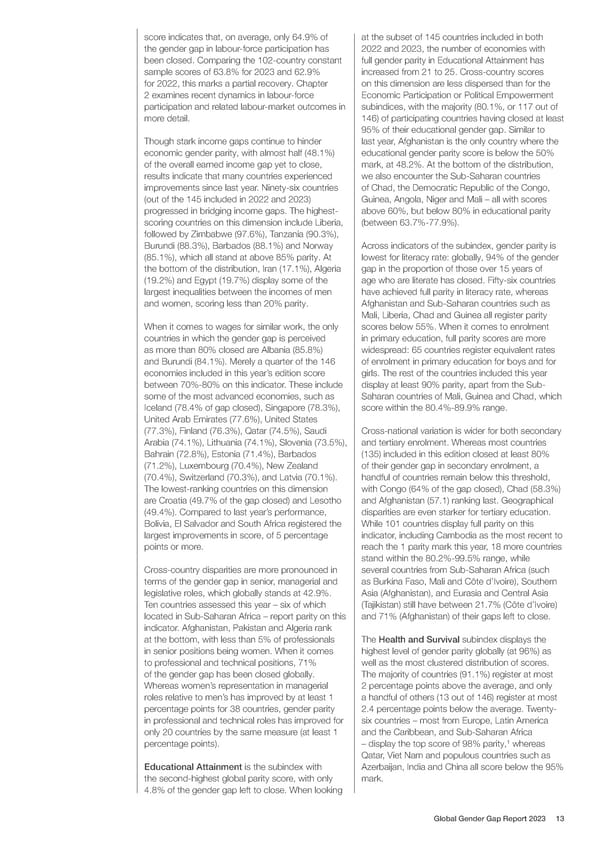score indicates that, on average, only 64.9% of at the subset of 145 countries included in both the gender gap in labour-force participation has 2022 and 2023, the number of economies with been closed. Comparing the 102-country constant full gender parity in Educational Attainment has sample scores of 63.8% for 2023 and 62.9% increased from 21 to 25. Cross-country scores for 2022, this marks a partial recovery. Chapter on this dimension are less dispersed than for the 2 examines recent dynamics in labour-force Economic Participation or Political Empowerment participation and related labour-market outcomes in subindices, with the majority (80.1%, or 117 out of more detail. 146) of participating countries having closed at least 95% of their educational gender gap. Similar to Though stark income gaps continue to hinder last year, Afghanistan is the only country where the economic gender parity, with almost half (48.1%) educational gender parity score is below the 50% of the overall earned income gap yet to close, mark, at 48.2%. At the bottom of the distribution, results indicate that many countries experienced we also encounter the Sub-Saharan countries improvements since last year. Ninety-six countries of Chad, the Democratic Republic of the Congo, (out of the 145 included in 2022 and 2023) Guinea, Angola, Niger and Mali – all with scores progressed in bridging income gaps. The highest- above 60%, but below 80% in educational parity scoring countries on this dimension include Liberia, (between 63.7%-77.9%). followed by Zimbabwe (97.6%), Tanzania (90.3%), Burundi (88.3%), Barbados (88.1%) and Norway Across indicators of the subindex, gender parity is (85.1%), which all stand at above 85% parity. At lowest for literacy rate: globally, 94% of the gender the bottom of the distribution, Iran (17.1%), Algeria gap in the proportion of those over 15 years of (19.2%) and Egypt (19.7%) display some of the age who are literate has closed. Fifty-six countries largest inequalities between the incomes of men have achieved full parity in literacy rate, whereas and women, scoring less than 20% parity. Afghanistan and Sub-Saharan countries such as Mali, Liberia, Chad and Guinea all register parity When it comes to wages for similar work, the only scores below 55%. When it comes to enrolment countries in which the gender gap is perceived in primary education, full parity scores are more as more than 80% closed are Albania (85.8%) widespread: 65 countries register equivalent rates and Burundi (84.1%). Merely a quarter of the 146 of enrolment in primary education for boys and for economies included in this year’s edition score girls. The rest of the countries included this year between 70%-80% on this indicator. These include display at least 90% parity, apart from the Sub- some of the most advanced economies, such as Saharan countries of Mali, Guinea and Chad, which Iceland (78.4% of gap closed), Singapore (78.3%), score within the 80.4%-89.9% range. United Arab Emirates (77.6%), United States (77.3%), Finland (76.3%), Qatar (74.5%), Saudi Cross-national variation is wider for both secondary Arabia (74.1%), Lithuania (74.1%), Slovenia (73.5%), and tertiary enrolment. Whereas most countries Bahrain (72.8%), Estonia (71.4%), Barbados (135) included in this edition closed at least 80% (71.2%), Luxembourg (70.4%), New Zealand of their gender gap in secondary enrolment, a (70.4%), Switzerland (70.3%), and Latvia (70.1%). handful of countries remain below this threshold, The lowest-ranking countries on this dimension with Congo (64% of the gap closed), Chad (58.3%) are Croatia (49.7% of the gap closed) and Lesotho and Afghanistan (57.1) ranking last. Geographical (49.4%). Compared to last year’s performance, disparities are even starker for tertiary education. Bolivia, El Salvador and South Africa registered the While 101 countries display full parity on this largest improvements in score, of 5 percentage indicator, including Cambodia as the most recent to points or more. reach the 1 parity mark this year, 18 more countries stand within the 80.2%-99.5% range, while Cross-country disparities are more pronounced in several countries from Sub-Saharan Africa (such terms of the gender gap in senior, managerial and as Burkina Faso, Mali and Côte d’Ivoire), Southern legislative roles, which globally stands at 42.9%. Asia (Afghanistan), and Eurasia and Central Asia Ten countries assessed this year – six of which (Tajikistan) still have between 21.7% (Côte d’Ivoire) located in Sub-Saharan Africa – report parity on this and 71% (Afghanistan) of their gaps left to close. indicator. Afghanistan, Pakistan and Algeria rank at the bottom, with less than 5% of professionals The Health and Survival subindex displays the in senior positions being women. When it comes highest level of gender parity globally (at 96%) as to professional and technical positions, 71% well as the most clustered distribution of scores. of the gender gap has been closed globally. The majority of countries (91.1%) register at most Whereas women’s representation in managerial 2 percentage points above the average, and only roles relative to men’s has improved by at least 1 a handful of others (13 out of 146) register at most percentage points for 38 countries, gender parity 2.4 percentage points below the average. Twenty- in professional and technical roles has improved for six countries – most from Europe, Latin America only 20 countries by the same measure (at least 1 and the Caribbean, and Sub-Saharan Africa 1 percentage points). – display the top score of 98% parity, whereas Qatar, Viet Nam and populous countries such as Educational Attainment is the subindex with Azerbaijan, India and China all score below the 95% the second-highest global parity score, with only mark. 4.8% of the gender gap left to close. When looking Global Gender Gap Report 2023 13
 Global Gender Gap Report 2023 Page 12 Page 14
Global Gender Gap Report 2023 Page 12 Page 14